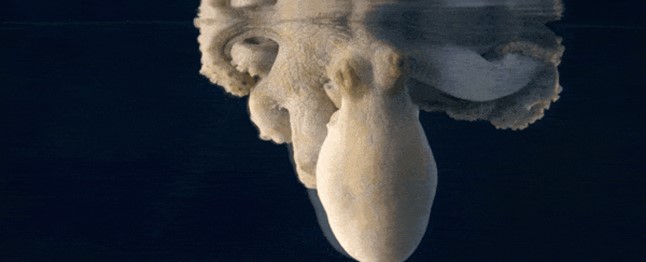
Credit: Nature on PBS, via YouTube
Octopuses are incredible, almost otherworldly creatures.
They can change their color, shape and texture in less than a tenth of a second—making them masters of camouflage.
With no bones, they can squeeze their entire bodies through tiny openings—making them great escape artists.
They’re highly intelligent and demonstrate short- and long-term memory. They learn to recognize people and have even been trained to operate a camera to take their picture.
They play, use tools and solve problems. They can learn how to open containers and do puzzles. They’ve even been seen stealing aboard fishing boats to eat crabs from a trap.
But this intelligence doesn’t work anything like ours—perhaps because they diverged from us evolutionarily more than 750 million years ago.
They have about the same number of neurons as a dog, but they’re distributed. A third are in a central donut-shaped brain that encircles their esophagus. The other two-thirds are in ganglia in each of their arms. This allows their arms to “think” their moves independently.
And all those neurons are processing a huge amount of sensory data from their environment.
Each of their hundreds of suckers can have more taste buds than a human tongue. Their skin has special proteins that allow it to sense the color of the surfaces it touches.
Imagine tasting with your fingers, seeing with your skin, and changing your shape and color to anything you want, and you can begin to appreciate the amazing octopus.
Background
Synopsis: Earth’s most intelligent invertebrates, octopuses, have many seemingly otherworldly traits, but they have lived in our oceans for hundreds of millions of years. They love to play and use tools, and their squishy bodies enable them to escape through tiny crevices. They can see with their skin, dream in camo, and taste with the suckers on their arms. They even evolve differently from other animals, editing their own RNA.
- Humans and octopuses couldn’t be much farther apart evolutionarily, having diverged more than 750 million years ago from a marine flatworm ancestor.
- Octopuses are coleoid cephalopods, like squids and cuttlefish.
- While vertebrates developed an internal skeleton, cephalopods evolved to have an external shell.
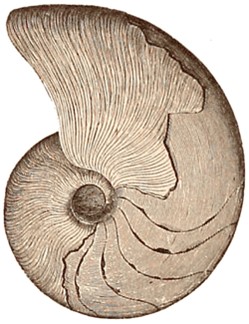
This Middle Devonian cephalopod (Goniatites vanuxemi) fossil from the Marcellus Formation lived sometime in the range of 384–392 million years ago, long before octopuses evolved.
Credit: JAMES D. DANA, public domain, via Wikimedia Commons - Coleoid cephalopods eventually left the shell behind, emerging soft bodied and much lighter in weight. Fossils of these creatures are rare because soft tissues are not easily preserved.
- The earliest fossil octopus ancestor, a vampyropod with bilateral suckers on its appendages, was found in 330-million-year-old Mississippian rocks in Montana.
- Today there are more than 300 species of octopuses that thrive in ecosystems ranging from shallow reefs to abyssal depths.
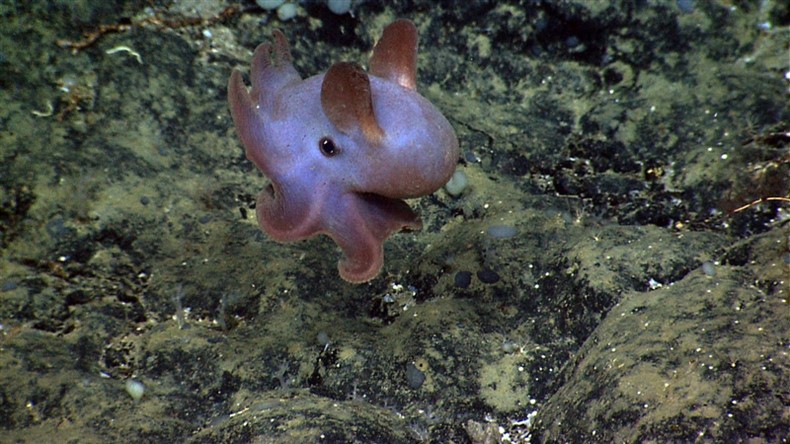
Dumbo octopuses (Grimpoteuthis) use their characteristic fins to steer and have been found globally at abyssal depths of 0.6–4.3 miles (1,000–7,000 meters).
Credit: NOAA
- Modern octopuses may seem alien because they demonstrate astonishing intelligence that evolved along a much different evolutionary path than our own.
- The brain-to-body ratio for octopuses is the largest of any invertebrate, with about as many neurons as a dog, but about two-thirds of them are located in its eight arms with a central donut-shaped brain encircling its esophagus.
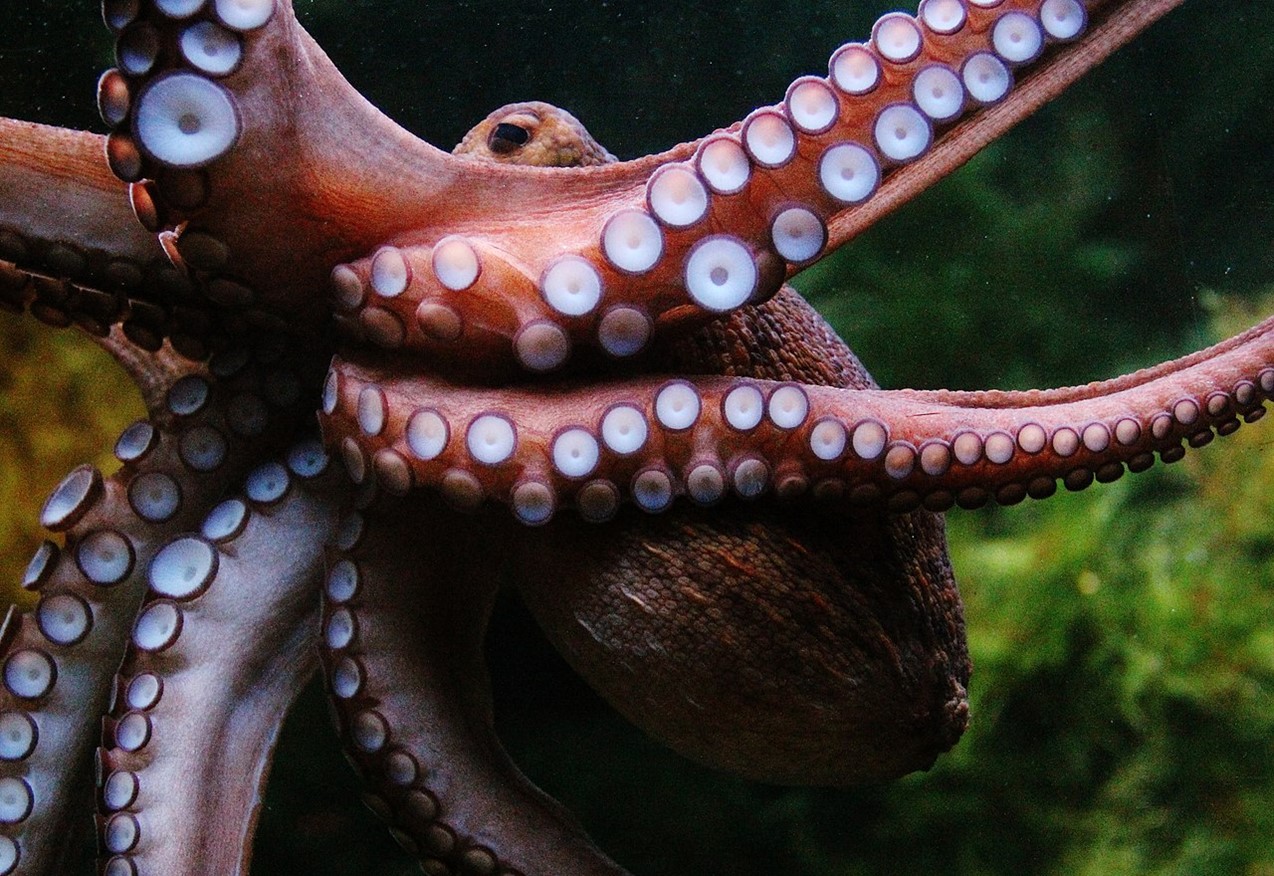
Two-thirds of an octopus's neurons are in the nerve cords of its arms. Severed arms are capable of complex reflex actions without input from the brain. If they lose one, their arms can regenerate in a few months.
Credit: damn_unique, via Wikimedia Commons - They are the only invertebrate known to play with objects and use tools (aside from some insects). One octopus in New Zealand even learned to use a camera to photograph people, and an Indonesian octopus planned ahead to use coconut shells for shelter.
- They have both short- and long-term memory and can recognize individual humans, reacting positively or negatively depending on past experiences.
- They are problem solvers, opening jars, learning how to solve puzzles, and making their famous and extraordinary escapes from labs.
- The brain-to-body ratio for octopuses is the largest of any invertebrate, with about as many neurons as a dog, but about two-thirds of them are located in its eight arms with a central donut-shaped brain encircling its esophagus.
- Along their evolutionary path, they also developed unusual and remarkable physical characteristics.
- They have three hearts that pump blue copper-based blood—two that pump it past the gills to pick up oxygen and one that circulates it around the body. Their blue blood is hemocyanin (as opposed to iron-based hemoglobin) that is more efficient at transporting oxygen in cold, low-oxygen conditions.
- They have no skeleton so can fluidly squeeze through tiny holes, but this can leave them vulnerable to predators. They do have a hard sharp beak and are mildly venomous but not fatal to humans.
- They only live one to five years. Males die after mating, and females tend their eggs until hatching, then die, so all octopuses are orphans.
- Octopuses have become masters of camouflage, especially since they have no exoskeleton for protection.
- Recent research has shown that they can “see” with their skin to match their background.
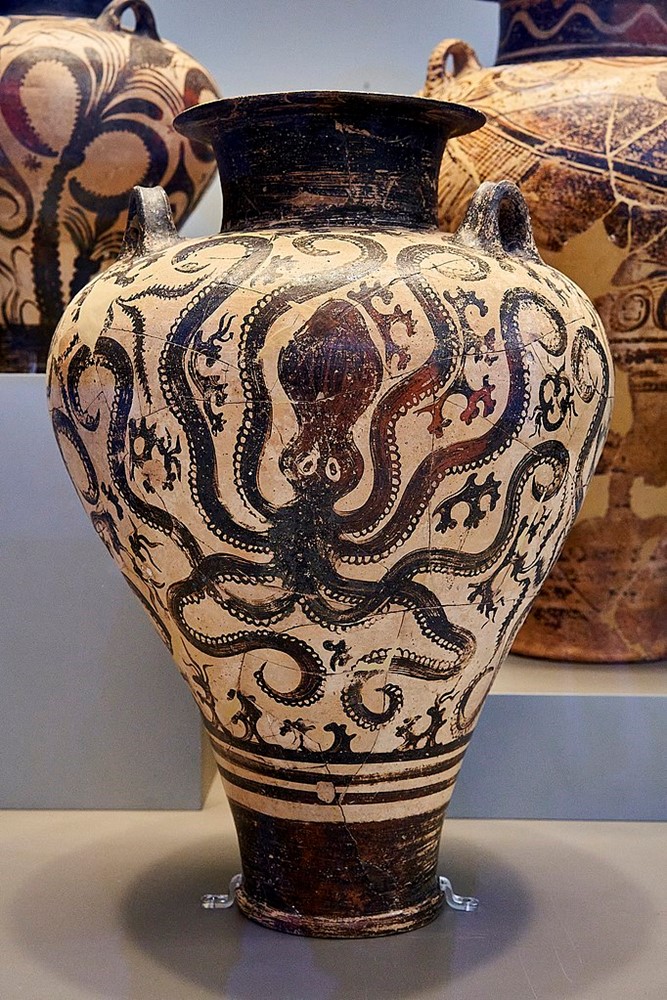
Around 2,400 years ago, Aristotle documented the remarkable capability of the octopus to instantaneously camouflage itself. This Mycenaean amphora from the fifteenth-century BC illustrates the long-term fascination of the Greeks with the októpus. The Greek plural would be octopodes, not the latin octopi, but the most common plural used is octopuses.
Credit: George E. Koronaios, via Wikimedia Commons - Almost all cephalopods can change their color, but the octopus demonstrates the quickest color transitions with the highest resolution patterns, including textures.
- They are able to adjust their color by flexing tiny star-shaped organs called chromatophores that are densely packed in three layers within their skin. Each layer reflects back a different color that overlays with the other layers. Iridophores add iridescence, while leucophores contain white pigment.
- Papillae can be relaxed for smooth texture or contracted for bumpy texture.
- Octopus color changes are astonishingly fast at as little as 0.1 second (compared to chameleons at seconds to more than a minute).
- Octopus eyes have only one type of photoreceptor, so they should be color blind. However, specialized proteins called opsins exist in their eyes that detect color differently than photoreceptors in most other animal eyes.
- When blindfolded, their arms change color in response to light intensity, indicating they can sense background colors in some other way.
- Recent studies have shown that when small skin patches are removed from octopus arms and exposed to background changes, they still change color.
- Researchers discovered that octopus skin contains opsins just like their eyes, so octopuses can “see” with their skin to aid their camouflage transitions.
- Scientists have recorded sleeping octopuses changing colors during active sleep cycles and hypothesize that they may dream short, simple dreams that cause them to respond with variations in camouflage.
- Recent research has shown that they can “see” with their skin to match their background.
- With one central brain and eight distributed ganglia bundles in their octopus arms, octopus appendages have more functionality than those of most animals. Their arms can operate autonomously, and they can use their suckers for both touching and tasting.
- Octopus arms have suckers along their length, while tentacles only have suction cups near the end of the appendage. Octopuses have eight arms and no tentacles, while both cuttlefish and squid have eight arms and two tentacles for feeding.
- The giant Pacific octopus has as many as 2,240 suckers, 280 per arm, and the largest near its beak-like mouth can be as much as 2.5 in (10 cm) across.
- Each sucker is individually controlled and can have more taste receptors than the human tongue.
- Octopuses use their arm-tongues for both touch-sensing and taste-sensing to map out their environments to sense danger and search for food.
- From a physical standpoint, octopus fossils indicate these animals haven’t changed much since the Jurassic Period, more than 150 million years ago.
- Now we know the reason why—unlike almost all other animals—they edit their RNA for survival instead of evolving via DNA, slowing their evolutionary progress.
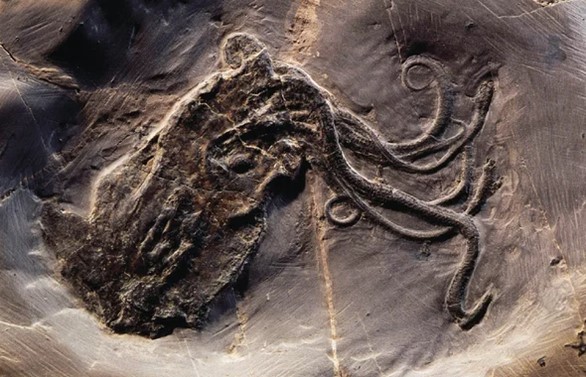
This unusually well-preserved 165-million-year-old fossilized octopus ancestor (Proteroctopus ribeti) from the Middle Jurassic of France has suckers on its eight arms.
Credit: Kruta, I. Rouget, S. Charbonnier, J. Bardin, V. Fernandez, D. Germain, A. Brayard, N. Landman, D. Korn, public domain, via Wikimedia Commons - DNA is like a recipe, while RNA is like a chef that implements that recipe.
- In most animals, the “chef” follows the recipe very closely, but in coleoid cephalopods, the “chef” has more of a tendency to improvise with different ingredients along the way.
- Octopuses that live in frigid waters edit their RNA to adjust critical nervous system proteins so that their nervous system can operate at colder temperatures.
- Their DNA is not altered, but RNA editing allows them to quickly adapt to their environment, improving survival. One species has shown the capability to adapt its metabolism to operate in increasing ocean acidification.
- But there is a downside. Since evolution occurs when genetic mutations alter DNA very slowly over time, RNA editing circumvents standard evolutionary processes for the animals slowing their evolution, as is obvious for the octopus.
- Now we know the reason why—unlike almost all other animals—they edit their RNA for survival instead of evolving via DNA, slowing their evolutionary progress.
- The Netflix documentary My Octopus Teacher is an uplifting story about the relationship between a diver and an octopus. Click on the image to view the trailer and enjoy the award-winning documentary to learn more about these amazing creatures.


